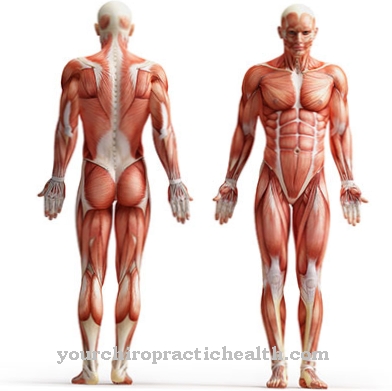The Multiple system atrophy is a neurological disease that belongs to the area of atypical Parkinson's syndromes. Atypical Parkinson’s syndromes often have similar symptoms to the relatively well-known Parkinson’s disease, but they often progress more rapidly, have a symmetrical distribution of symptoms even at the onset of the disease, respond less well to the Parkinson’s drug L-Dopa and otherwise differ in terms of some abnormalities from the "Orginial" Parkinson. The distinction is often difficult and definitely a case for a neurologist. Nevertheless, here is a brief overview of the MSA.
What is multiple system atrophy?

© bilderzwerg - stock.adobe.com
The Multiple System Atrophy (MSA) refers to a sporadic neurodegenerative disease in middle adulthood, which is characterized by a combination of disorders of the autonomic nervous system (see below) with Parkinson's symptoms or cerebellar ataxia.
In the meantime, the term MSA summarizes some long-known clinical pictures that were originally considered to be independent diseases: Shy-Drager syndrome, sporadic olivo-ponto-cerebellar atrophy and striatonigral degeneration, which is the most common form of manifestation with pronounced autonomic disorders Disorders and extrapyramidal disorders is.
About 4 in 100,000 people develop MSA. Parkinson's is about 50 times more common.
causes
The etiology, i.e. the mechanism by which the Multiple system atrophy is unknown, the research area is very complex even for experts. Atypical Parkinson’s syndromes are classified mainly according to neuropathological findings, i.e. according to certain criteria that can only be detected under the microscope (and thus often only after the person concerned has died).
The characteristic finding in the case of MSA is the detection of alpha-synuclein-positive inclusion bodies in the oligodendrocytes of the brain. It is a protein that is deposited in these "supporting cells" of the brain without knowing the exact reason or origin. Like Parkinson's disease and Lewy body dementia, MSA is therefore classified as a synucleinopathy.
One also observes a loss of nerve cells in different areas of the brain, which ultimately causes the symptoms and progresses rapidly. The degeneration in the substantia nigra is typical of Parkinson's and therefore causes symptoms similar to Parkinson's, but at the same time in MSA tissue containing dopamine receptors is also lost in the striatum and causes non-response to dopamine as a drug, which in turn is MSA differs from Parkinson's disease.
The death of nerve tissue in the cerebellum and the pons is responsible for cerebellar ataxia. The death of nerve tissue in the spinal cord is blamed for the dysfunction of the autonomic nervous system.
Symptoms, ailments & signs
Multiple system atrophy is characterized by a variety of neurological and physical symptoms. Over time, the symptoms worsen. The ability to walk is lost after about three to five years. Death usually occurs after eight to ten years. There are two possible courses of disease.
The so-called Parkinson's symptoms predominate in one. The other course of the disease shows mainly cerebellar symptoms. In the context of parkinsonism, the predominant symptoms are tremor (shaking), muscle stiffness (rigidity) and slowing of movements (bradykinesia). In the case of the cerebellar forms, coordination disorders of movement (stance and gait ataxia) with constant risk of falling, pathological sleepiness (nystagmus) and disorders of voluntary movement sequences (dysmetria) are observed.
In addition to these symptoms, swallowing disorders, speech disorders, constant blood pressure fluctuations, low blood pressure, erectile dysfunction and urinary incontinence can also occur. Dementia also often develops. In addition, signs of the pyramid orbit appear, which are expressed by an increased willingness to reflex or by a positive Babinski reflex. In the Babinski reflex, the big toe moves outwards when brushing the sole of the foot, in contrast to the normal reflex.
However, not all symptoms have to be present with the disease. The symptoms depend heavily on which systems are affected. Life expectancy is significantly reduced by complications such as aspiration pneumonia with swallowing disorders or severe breathing disorders. Therapy is especially not possible for cerebellar multiple system atrophy. Overall, the multiple system atrophy cannot currently be cured.
Diagnosis & course
The Multiple system atrophy is clinically noticeable due to the combination of autonomic disorders with Parkinson's symptoms or cerebellar ataxia.
Autonomous disorders include those of the autonomic nervous system, i.e. that part of our nervous system that regulates bodily processes in daily life without our voluntary control and influence: disorders of blood pressure regulation, bladder emptying disorders, sleep, speech and swallowing disorders can occur in this context. Swallowing disorders in particular can quickly become dangerous if food residues enter the lower airways through a malfunction and trigger pneumonia there - such aspiration pneumonia is a common cause of death in MSA patients.
In medicine, Parkinson's symptoms are a combination of rigor, tremor and akinesia. The symptom rigor describes an increase in muscular tone up to a willfully unbreakable muscle rigidity, a tremor is a fine-pitched muscle tremor (e.g. of the hands), the akinesia (or somewhat less pronounced: hypokinesis) describes a lack of movement, which is caused by a lack of drive in the brain . Overall, there is an impoverishment of facial expressions and gestures, a bent posture, a slowdown in reaction and therefore a tendency to fall forwards, as well as the typical small-stepped gait of Parkinson's patients.
Cerebellar ataxia can also occur in MSA and describes a disorder of movement and posture coordination, which has its cause in the cerebellum (cerebellum). For example, there may be a tendency to fall while walking or standing.
The basic pillars of diagnosis are the anamnesis and clinical examination. Here, based on the rough description and the appearance, which is also visible to the doctor, conclusions can be drawn about Parkinson's syndrome. However, the exact diagnosis of Parkinson's syndromes is often difficult even for a specialist.
Autonomous regulatory disorders are always mandatory for MSA, everything else can be added, but does not always have to be. Some characteristics such as swallowing and speech disorders, a tendency to fall early on and rapid progression of the disease are more likely to suggest MSA - but in particular the non-response to L-Dopa as a drug often only helps the doctor to differentiate it from "normal" Parkinson's disease.
In difficult cases, imaging using CT, MRI or IBZM-SPECT can help and detect atrophied brain regions (CT, MRT) or the lack of dopamine receptors (SPECT).
Complications
Due to the multiple system atrophy, symptoms similar to Parkinson's disease occur in most cases. These complaints can lead to significant restrictions and complications in the everyday life of the patient, so that he has to rely on the help of other people. This leads to paralysis and disorders of sensitivity, which can also lead to restricted mobility. The patients suffer from disorders of concentration and also from motor disorders.
Furthermore, the patients often find it difficult to speak and they have difficulty swallowing. These can lead to problems with ingesting fluids and food, so that those affected suffer from deficiency symptoms or dehydration. Furthermore, there is tension and muscle weakness. Those affected often tremble and suffer from anxiety or depression.
The patient's quality of life is significantly reduced and restricted by the multiple system atrophy. It is also not uncommon for inflammations to occur in the lungs, which in the worst case can lead to death of the patient. A direct and causal treatment of this disease is usually not possible.
The symptoms can, however, be limited by various therapies and with the help of medication. In most cases, multiple system atrophy will reduce the patient's life expectancy.
When should you go to the doctor?
Unsteady gait and mobility disorders are signs of a health impairment that must be examined by a doctor. A doctor is required in the event of a weakness in physical performance, a low level of resilience or a decrease in mobility. If the person concerned suffers from trembling limbs, inner restlessness or disorders of voluntary movements, a doctor must be consulted. Often, sufferers of multiple system atrophy are no longer able to safely and stably reach the intended goals while moving.
If the day-to-day obligations can no longer be fulfilled, the general risk of accidents and falls increases and injuries often occur, a doctor must be consulted. If normal sporting activities can no longer be carried out, if there is a restriction in the daily routine or if vegetative complaints arise, the person concerned needs help and support. In the case of incontinence, changes in memory, disorders of the swallowing act, and problems with vocalisation, a doctor should be consulted.
Irregular heartbeats, confusion, orientation problems, behavioral problems and decreased wellbeing are complaints that should be presented to a doctor.A diffuse feeling of illness, social withdrawal or visual changes due to weight fluctuations are indications of the organism that should be clarified. Since the disease has a progressive course, a doctor should be consulted at the first discrepancy.
Treatment & Therapy
The therapy of Multiple system atrophy is always multi-track and mostly difficult. Only a third of the patients respond to the L-Dopa therapy, which is otherwise common in Parkisone, and usually only for a limited period of time. Amantadine is a drug that can alternatively help against movement disorders.
The autonomic disorders must be treated symptomatically with copious fluid intake or blood pressure medication to counteract the usually low blood pressure, bladder emptying disorders are addressed either with insoles or with single-use catheterization, and in more severe cases of incontinence medication can also be tried. An accompanying depression should be treated with medication as early as possible.
To alleviate suffering (palliation) in advanced stages, it is often helpful and necessary to insert a nasogastric tube or ventilation with a mask. A specific therapy using immunoglobulins is currently being researched.
You can find your medication here
➔ Medicines to calm down and strengthen nervesOutlook & forecast
The prognosis for multiple system atrophy is very poor. The same applies to both quality of life and life expectancy. The disease progresses rapidly. Three to five years after a diagnosis, patients suffer from severe balance disorders. The ability to walk is limited or no longer available. The first affected people regularly die from the eighth year of symptoms. Science has not yet produced an effective means of effectively combating multiple system atrophy. Only the symptoms can be alleviated so that the sick do not have to suffer any pain.
The greatest risk of developing multiple system atrophy lies in people at an advanced stage of life. Most patients are diagnosed shortly before the age of 60. Statistically, ten diseases per 100,000 inhabitants are documented. According to the current status, the risk for men and women is the same.
A normal everyday life is no longer possible due to the typical signs. Those affected increasingly need help in everyday life. Last but not least, the diagnosis also leads to leaving the profession. Many patients and their relatives complain of psychological stress that results from the untreatable multiple system atrophy.
prevention
According to the current state of science, prevention against multiple system atrophy is not possible.
Aftercare
In the case of multiple system atrophy, in most cases only very few and sometimes very limited follow-up measures are available. For this reason, the person concerned should consult a doctor at an early stage to prevent other complications or complaints from occurring. Self-healing cannot occur, so that the early diagnosis of the disease is in the foreground.
As a rule, those affected with multiple system atrophy are dependent on the intake of various drugs that can alleviate the symptoms. In any case, the person affected should follow all the doctor's instructions and ensure the correct dosage and regular intake of the medication. If anything is unclear or if you have any questions, it is advisable to consult a doctor first.
Likewise, many of the patients are dependent on the help and care of other people in their everyday life due to the multiple system atrophy, whereby the care provided by their own families can have a positive effect on the course of the disease. Further follow-up measures are usually not available to the affected person. The further course of the disease is strongly dependent on the cause, so that no general prediction can be made.
You can do that yourself
Everyday help and self-help for patients with multiple system atrophy primarily focuses on the symptoms and depends on the exact symptoms.
If the blood pressure is too low, support stockings and a resting position with the head slightly elevated are suitable. In this way the blood circulation is relieved. In addition, an increased fluid intake and a slightly higher salt diet are recommended. If there are problems with the swallowing muscles, the diet should be adjusted accordingly. Avoid dry, chew-intensive food.
In order to delay the loss of motor skills as much as possible, regular physiotherapy exercises are an approach worth mentioning. Both fine and gross motor skills should be considered. A positive side effect of these exercises also has an effect on blood pressure. The same is also recommended for the speech muscles. Regular exercise can prevent a rapid loss of language skills.
Patients should also be careful not to isolate themselves from their surroundings despite the disease and the symptoms it causes. On the one hand, the exercises already mentioned, especially the linguistic ones, can be tried out better in everyday life, on the other hand, possible psychological effects are weakened.


.jpg)









.jpg)



.jpg)










.jpg)
